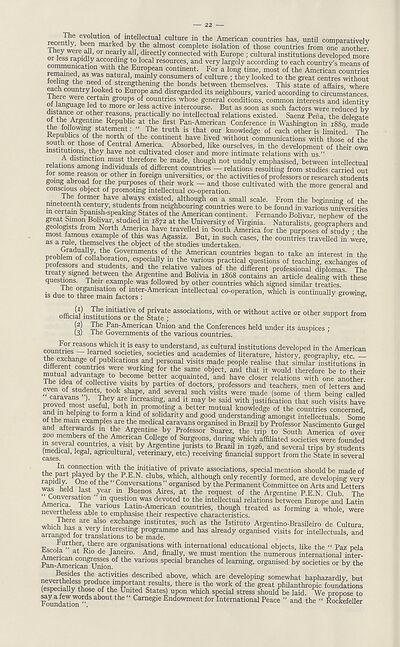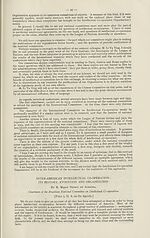International > Proceedings of the second General conference of national committees on intellectual co-operation, Paris, July 5th-9th, 1937
(24)
Download files
Complete book:
Individual page:
Thumbnail gallery: Grid view | List view

— 22
rprpnf 1 utlon of ^tellectual culture in the American countries has, until comparatively
Thp^ fi11 mar^e^ almost complete isolation of those countries from one another,
nr lps<;Were,m ' 0r neai; ^ all, directly connected with Europe ; cultural institutions developed more
or less rapidly according to local resources, and very largely according to each country’s means of
communication with the European continent. For a long time, most of the American countries
remained, as was natural, mainly consumers of culture ; they looked to the great centres without
feeling the need of strengthening the bonds between themselves. This state of affairs where
Th^re0 we^ rert^nV0 andfdisre^rded its neighbours, varied according to circumstances.
re certain groups of countries whose general conditions, common interests and identity
ot language led to more or less active intercourse. But as soon as such factors were reduced bv
is ance or other reasons, practically no intellectual relations existed. Saenz Pena the delegate
tlie11Argentmf RePublic at the first Pan-American Conference in Washington in 1880, rnade
e following statement: “ The truth is that our knowledge of each other is limited! The
epu hesof the north of the continent have lived without communications with those of the
°f Pntral Amfrica- Absorbed, like ourselves, in the development of their own
nstitutions, they have not cultivated closer and more intimate relations with us.”
dlstinctl01? ^ust therefore be made, though not unduly emphasised, between intellectual
for am0ng mdiyiduals of different countries — relations resulting from studies carried out
for some reason or other in foreign universities, or the activities of professors or research students
going abroad for the purposes of their work — and those cultivated with the more general and
conscious object of promoting intellectual co-operation.
haV? always, existed> although on a small scale. From the beginning of the
in V students from neighbouring countries were to be found in various universities
Sp J Si™ SPanish-sPeaking States of the American continent. Fernando Bolivar, nephew of the
great Simon Bolivar, studied in 1872 at the University of Virginia. Naturalists geographers and
geologi;*5 from North America have travelled in South America for the purpose® of study ; the
most famous example of this was Agassiz. But, in such cases, the countries travelled in were
as a rule, themselves the object of the studies undertaken.
oroblpm^rnPaSf ^overnments of.the American countries began to take an interest in the
problem of collaboration, especially in the various practical questions of teaching, exchanges of
p ofessors and students, and the relative values of the different professional diplomas. The
^at7 Slgned detween the Argentine and Bolivia in 1868 contains an article dealing with these
q e rions. Their example was followed by other countries which signed similar treaties
is dul toZ“nnfa0ctOTsTAmeriCan intelleCtUal c°-°P<™tion, which is continually growing,
officiinnsTuutTon^orthi Stlte^ aSS0ciati°nS- With or without active or other suPP»t from
|2\ Ran"Amer^can Union and the Conferences held under its auspices •
(3j I he Governments of the various countries.
^iiTZ0r reasons which it is easy to understand, as cultural institutions developed in the American
ountnes learned societies, societies and academies of literature, history, geography etc —
the exchange of publications and personal visits made people realise that similar institutions in
^0un^ries working for the same object, and that it would therefore be to their
Thp1 -h1 adyanta&e t0 become better acquainted, and have closer relations with one another
The idea of collective visits by parties of doctors, professors and teachers, men of letters and
^cTravan^r^Th0^ ^ ^ “ SUCh V-tS Were made (some them bring called
Ih1ey^ar? mcTea-smS, and it may be said with justification that such visits have
proved most useful, both in promoting a better mutual knowledge of the countries concerned
o?th?marnelamrip?11 a of ®olidarity and good understanding amongst intellectuals. Some
ot the main examples are the medical caravans organised in Brazil by Professor Nascimento Gurgel
and afterwards m the Argentine by Professor Suarez, the trip to South America of over
00 members of the American College of Surgeons, during which affiliated societies were founded
f iC°TtrieS’ ai V1S1\ by ArgenUne jurists to Brazil in 1926, and several trips by students
r^fpt 'lega ’ agriCU tura ’ vetermary, etc.) receiving financial support from the State m several
CcloCS.
the 0fPriv^? associations. special mention should be made of
ranidfv fwVeh *erP'E N' clubs which, although only recently formed, are developing very
wiThe'u ^ 1 f he 90n^ersatl0nAs. organised by the Permanent Committee on Arts and Letters
as held last year m Buenos Aires, at the request of the Argentine P.E.N. Club The
x£n m(luestTlon was devoted to the intellectual relations between Europe and Latin
neveShplpJ^J?ri°US Ratm-A”lerican countries, though treated as forming a whole, were
evertheless able to emphasise their respective characteristics.
whGh w are alS? ,exchan^e institutes, such as the Istituto Argentino-Brasileiro de Cultura
nrramxrWnr ^ }n}eTes^nS programme and has already organised visits for intellectuals, and
arranged tor translations to be made.
Fcrn^U”th!r,T?the^e aTre organisations with international educational objects, like the “ Paz pela
Amprtan^™ de finally' we must mention the numerous international inter-
Pan-AmericangUrioSn0f the Vari°US sPecial branches of learning, organised by societies or by the
npvpf+lfiw the/ctivities described above, which are developing somewhat haphazardly, but
(^SDeria^vSthoqpdnfC+hT1U0^aI^^c;+eS^U^^S, there W°rk °f the great Philanthropic foundations
(especially those of the United States) upon which special stress should be laid. We propose to
iSundariori0”^5^0^ tke^arnegie Endowment for Interrmtional Peace ” and the “ Rockefeller
rprpnf 1 utlon of ^tellectual culture in the American countries has, until comparatively
Thp^ fi11 mar^e^ almost complete isolation of those countries from one another,
nr lps<;Were,m ' 0r neai; ^ all, directly connected with Europe ; cultural institutions developed more
or less rapidly according to local resources, and very largely according to each country’s means of
communication with the European continent. For a long time, most of the American countries
remained, as was natural, mainly consumers of culture ; they looked to the great centres without
feeling the need of strengthening the bonds between themselves. This state of affairs where
Th^re0 we^ rert^nV0 andfdisre^rded its neighbours, varied according to circumstances.
re certain groups of countries whose general conditions, common interests and identity
ot language led to more or less active intercourse. But as soon as such factors were reduced bv
is ance or other reasons, practically no intellectual relations existed. Saenz Pena the delegate
tlie11Argentmf RePublic at the first Pan-American Conference in Washington in 1880, rnade
e following statement: “ The truth is that our knowledge of each other is limited! The
epu hesof the north of the continent have lived without communications with those of the
°f Pntral Amfrica- Absorbed, like ourselves, in the development of their own
nstitutions, they have not cultivated closer and more intimate relations with us.”
dlstinctl01? ^ust therefore be made, though not unduly emphasised, between intellectual
for am0ng mdiyiduals of different countries — relations resulting from studies carried out
for some reason or other in foreign universities, or the activities of professors or research students
going abroad for the purposes of their work — and those cultivated with the more general and
conscious object of promoting intellectual co-operation.
haV? always, existed> although on a small scale. From the beginning of the
in V students from neighbouring countries were to be found in various universities
Sp J Si™ SPanish-sPeaking States of the American continent. Fernando Bolivar, nephew of the
great Simon Bolivar, studied in 1872 at the University of Virginia. Naturalists geographers and
geologi;*5 from North America have travelled in South America for the purpose® of study ; the
most famous example of this was Agassiz. But, in such cases, the countries travelled in were
as a rule, themselves the object of the studies undertaken.
oroblpm^rnPaSf ^overnments of.the American countries began to take an interest in the
problem of collaboration, especially in the various practical questions of teaching, exchanges of
p ofessors and students, and the relative values of the different professional diplomas. The
^at7 Slgned detween the Argentine and Bolivia in 1868 contains an article dealing with these
q e rions. Their example was followed by other countries which signed similar treaties
is dul toZ“nnfa0ctOTsTAmeriCan intelleCtUal c°-°P<™tion, which is continually growing,
officiinnsTuutTon^orthi Stlte^ aSS0ciati°nS- With or without active or other suPP»t from
|2\ Ran"Amer^can Union and the Conferences held under its auspices •
(3j I he Governments of the various countries.
^iiTZ0r reasons which it is easy to understand, as cultural institutions developed in the American
ountnes learned societies, societies and academies of literature, history, geography etc —
the exchange of publications and personal visits made people realise that similar institutions in
^0un^ries working for the same object, and that it would therefore be to their
Thp1 -h1 adyanta&e t0 become better acquainted, and have closer relations with one another
The idea of collective visits by parties of doctors, professors and teachers, men of letters and
^cTravan^r^Th0^ ^ ^ “ SUCh V-tS Were made (some them bring called
Ih1ey^ar? mcTea-smS, and it may be said with justification that such visits have
proved most useful, both in promoting a better mutual knowledge of the countries concerned
o?th?marnelamrip?11 a of ®olidarity and good understanding amongst intellectuals. Some
ot the main examples are the medical caravans organised in Brazil by Professor Nascimento Gurgel
and afterwards m the Argentine by Professor Suarez, the trip to South America of over
00 members of the American College of Surgeons, during which affiliated societies were founded
f iC°TtrieS’ ai V1S1\ by ArgenUne jurists to Brazil in 1926, and several trips by students
r^fpt 'lega ’ agriCU tura ’ vetermary, etc.) receiving financial support from the State m several
CcloCS.
the 0fPriv^? associations. special mention should be made of
ranidfv fwVeh *erP'E N' clubs which, although only recently formed, are developing very
wiThe'u ^ 1 f he 90n^ersatl0nAs. organised by the Permanent Committee on Arts and Letters
as held last year m Buenos Aires, at the request of the Argentine P.E.N. Club The
x£n m(luestTlon was devoted to the intellectual relations between Europe and Latin
neveShplpJ^J?ri°US Ratm-A”lerican countries, though treated as forming a whole, were
evertheless able to emphasise their respective characteristics.
whGh w are alS? ,exchan^e institutes, such as the Istituto Argentino-Brasileiro de Cultura
nrramxrWnr ^ }n}eTes^nS programme and has already organised visits for intellectuals, and
arranged tor translations to be made.
Fcrn^U”th!r,T?the^e aTre organisations with international educational objects, like the “ Paz pela
Amprtan^™ de finally' we must mention the numerous international inter-
Pan-AmericangUrioSn0f the Vari°US sPecial branches of learning, organised by societies or by the
npvpf+lfiw the/ctivities described above, which are developing somewhat haphazardly, but
(^SDeria^vSthoqpdnfC+hT1U0^aI^^c;+eS^U^^S, there W°rk °f the great Philanthropic foundations
(especially those of the United States) upon which special stress should be laid. We propose to
iSundariori0”^5^0^ tke^arnegie Endowment for Interrmtional Peace ” and the “ Rockefeller
Set display mode to:
![]() Universal Viewer |
Universal Viewer | ![]() Mirador |
Large image | Transcription
Mirador |
Large image | Transcription
Images and transcriptions on this page, including medium image downloads, may be used under the Creative Commons Attribution 4.0 International Licence unless otherwise stated. ![]()
| League of Nations > International > Proceedings of the second General conference of national committees on intellectual co-operation, Paris, July 5th-9th, 1937 > (24) |
|---|
| Permanent URL | https://digital.nls.uk/195217487 |
|---|
| Shelfmark | LN.XII |
|---|
| Description | Over 1,200 documents from the non-political organs of the League of Nations that dealt with health, disarmament, economic and financial matters for the duration of the League (1919-1945). Also online are statistical bulletins, essential facts, and an overview of the League by the first Secretary General, Sir Eric Drummond. These items are part of the Official Publications collection at the National Library of Scotland. |
|---|---|
| Additional NLS resources: |
|

